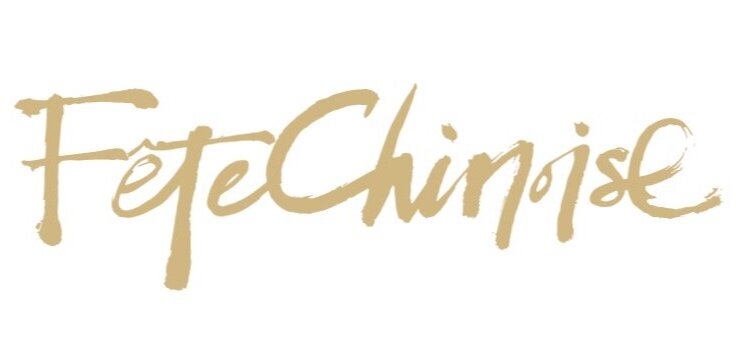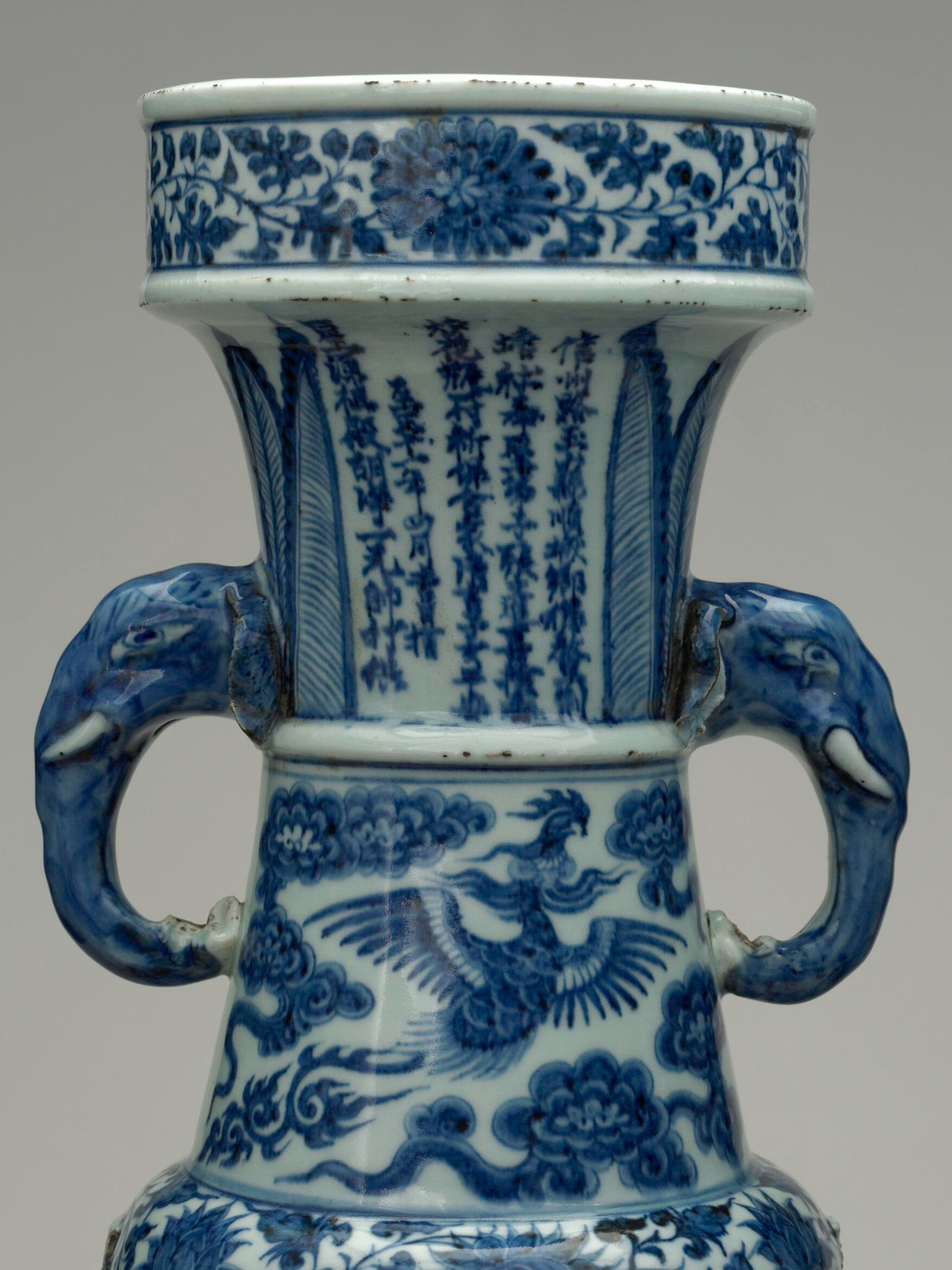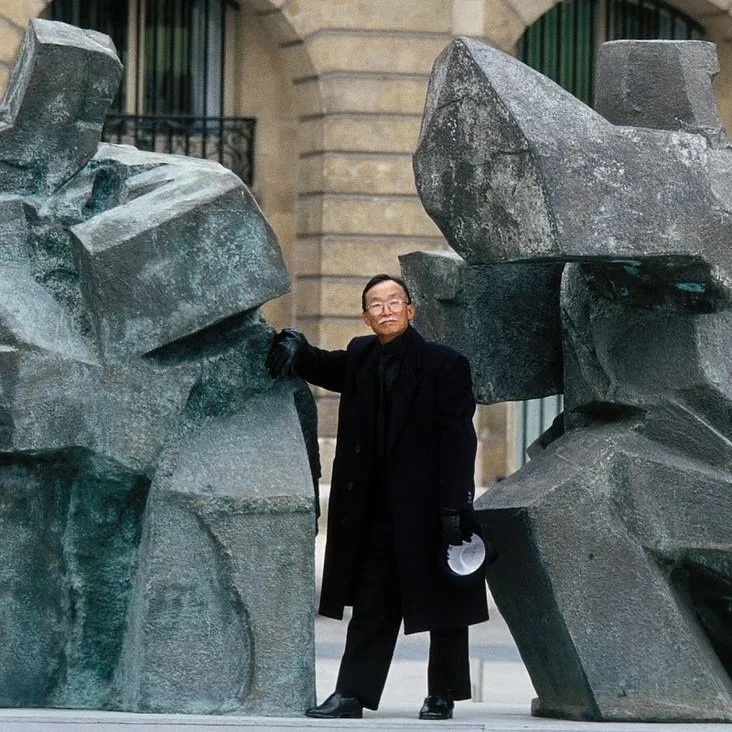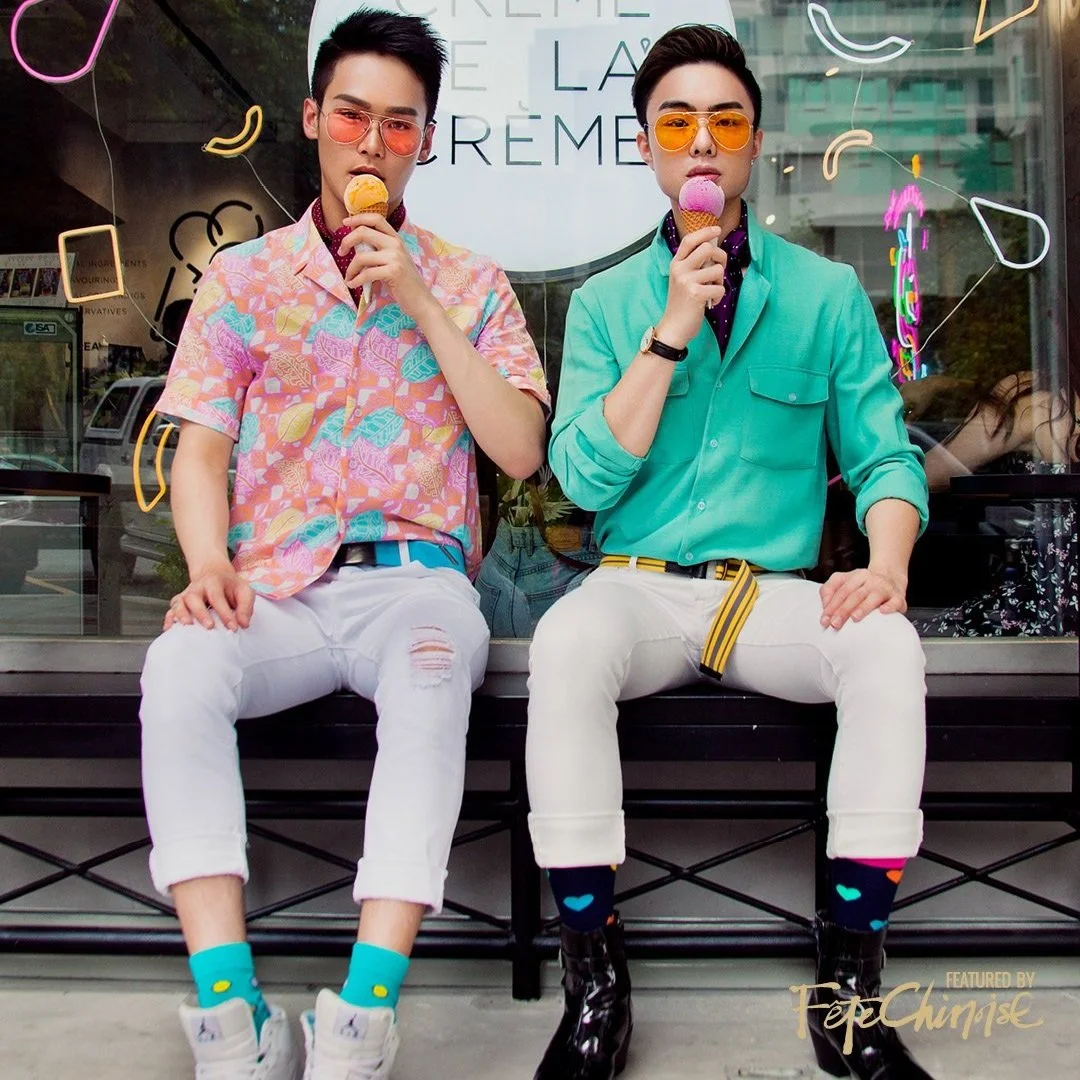7 most important Chinese porcelains in western collections 中國瓷器的魅力: 西方收藏的賞心七最
Written by Ting Zhang
Translated by The Fête Chinoise Team
My work allows me to go in and out of major museums from time to time during working hours. Today I will introduce to you some highly skilled and extremely rare Chinese ceramics in major overseas museums in accordance with the times for everyone to enjoy.
考古學目前可知最早的陶瓷器出現在中國距今2萬年的時間。與此同時中國人發明了瓷器,很多人認為陶瓷是火與土的藝術。作為一名亞洲藝術顧問,幸運的是,我的工作中時常要擺弄這些陶瓷,往返於各大拍賣會,博物館圖書館之間,用最快的時間幫助我的客人推斷出一件陶瓷器的年代、特徵、來源、其自身價值和市場價值。
我的工作讓我時常能在工作時間進出各大博物館,今天和大家按照時代先後為大家介紹在海外的各大博物館中的一些技術精湛且極其稀有的中國陶瓷器供大家欣賞。
1. Northern Qi Celadon Lotus Statue 北齊青釉蓮花尊
There is a city in Missouri in the central part of the United States called Kansas City. Many people have heard of it because it is probably because there is a century-old bbq grill Arthur Bryant's that has been popular with celebrities from all walks of life in the United States. The celebrities who patronize here include Hollywood stars, well-known athletes and Presidents such as Clinton and Obama. In this city is also the The Nelson-Atkins Museum of Art, a museum with many national treasures. In its Chinese exhibition hall, there is a 52 cm tall vessel with a layer of green glaze attached to the complex and exquisite lotus. This commands a lot of respect, because 52 cm is a very large size among the utensils fired during that time period when it was created. This lotus statue integrates various decorative techniques such as portraying, embossing, piling, molding, and pasting. The decorative patterns are divided into nine layers, namely honeysuckle pattern, dragon pattern, lotus pattern, bodhi leaf pattern, group pattern, etc. Alternately. It was burnt during the reign of the northern peoples during the Northern Dynasties. It was used as the funerary of the nobles at that time. Its specific purpose is unknown, but experts speculate that the porcelain vase may have the same function as the soul vase placed in the Egyptian tombs. Since the Northern Dynasties were the rule of the northern peoples, Buddhism prevailed at that time, so the decorations on this statue have strong Buddhist symbols. This lotus statue was purchased by the museum in 1940 from the famous Chinese antique dealer Yamanaka Chamber of Commerce in Japan. It is worth mentioning that this lotus statue is also the only one in overseas museums, so it is especially important. The level of craftsmanship is exquisite, and similar artifacts are also rare in China. At present, the only reference to this lotus statue is the four lotus statues unearthed in 1948 from the tomb of the Feng family in Jingxian County, Hebei Province. These four were collected by the Hebei Provincial Museum, the National Museum and the Forbidden City Museum respectively, and were designated as national first-class unearthed cultural relics. Compared with the four lotus statues unearthed in Hebei, this one is slightly smaller in size of 52 cm, and the ring system on the shoulder is 4 less than two unearthed artifacts in China, but there is indeed a past in the pasting technique. Too much.
“In the current fast-paced social environment of digital innovation, both artists and museums are facing various challenges. Traditional curatorial methods can no longer attract a new generation of people to visit the museum. What needs to be updated is new curatorial concepts and new ones.”
在美國的中部的密蘇裏州有一座城市叫做堪薩斯城的城市,很多人聽說過這裏很有可能是因為這裏有一家受到美國各界名流青梅的百年燒烤店Arthur Bryant’s,光顧這裏的明星包括好萊塢明星,知名運動員以及克林頓和奧巴馬等總統大人。 然而就在這座城市坐落著一家擁有衆多國寶級文物的博物館 The Nelson-Atkins Museum of Art,在其中國展廳中有這樣一件高52厘米器身附有一層綠釉造型繁複,精美無比的蓮花尊。52 厘米在當時燒造的器物中是非常大的尺寸。此件蓮花尊將刻畫、浮雕、堆塑、模印、粘貼等多種裝飾技法施于一體,裝飾紋飾分為九層,分別為忍冬紋、龍紋、蓮紋、菩提葉紋、團花紋等交替而成。是北朝時期北方民族統治時期燒造的産物,用于當時貴族的隨葬品,其具體的用途未知,但是專家推測,瓷瓶可能和在埃及墓葬裏面擺置的魂瓶有著相同的作用。 由於北朝時期,是北方民族統治時期,當時盛行佛教,所以此尊上的紋飾有著極強的佛教符號。 這只蓮花尊是博物館於1940年從日本的著名的中國文物古董商山中商會購入。值得一提的是這只蓮花尊也是在海外博物館中唯一的一只所以尤為重要。 工藝水平之精細,類似的器物在國內也是罕有,目前能和此件蓮花尊作參照的只有在1948年河北景縣封氏墓出土的四件蓮花尊作比較相媲美。 這四只分別被河北省博物館、國家博物館和故宮博物館收藏,並且定為國家一級出土文物。 和河北出土的四件蓮花尊比起來,這一件從尺寸上略小為52厘米,肩上的環型系為4個 比國內出土器物少兩個,但是在貼塑技藝上確是有過之而不及。
2. Tang Sancai Horse 唐三彩駿馬
Sponsored by Piaget.
We all know that the Tang Dynasty was a great period in Chinese history. With its enlightened policies, the economy and culture of the Tang Dynasty were advancing by leaps and bounds. The art works of the Tang Dynasty not only influenced the development of art after China, but also affected countries around China. The famous Tang Sancai art was born in this period. Tang Sancai is a kind of pottery with glaze. After being fired in the kiln twice, the wares with colored glaze and different shapes are created. According to research, although Sancai porcelains are funeral objects and there are many in number, there was indeed a unified royal arrangement at that time and designated factories were fired according to a hierarchical system and distributed to officials, royal relatives and nobles for burial. The larger the model and the more exquisite the shape of the three-color ware, the higher the rank of the official who was sacrificed. Moreover, the modeling is not only vivid and lifelike, even the clothes and utensils worn by the characters and animals are copied according to the original high-simulation, which provides us with a lot of information about the fashion of the Tang Dynasty at that time. Among the three-color artifacts, the horses of the Tang Dynasty have always been loved by collectors for their vivid shapes and exquisite details. The one I introduced is just a typical example. This three-color horse was originally collected by the famous British Railway Foundation, which has obtained huge profits by establishing an art fund to invest in art. It has been an important study case for the study of the art fund. In 1989, this horse was auctioned at Sotheby's in London, and it was the cover lot of the auction, which attracted the attention of countless collectors. It was finally sold at a price of 3.74 million pounds and broke the three-color instrument at auction. The market record has not yet been broken. In 2019, when attending the Tubo and Silk Road seminar in Dunhuang and visiting the Tubo and Silk Road special exhibition, I was fortunate to see this famous British Railway Fund three-color horse. I was very excited at that time. This horse is currently in the collection of the Pritzker family in the United States.
我們都知道唐朝是中國曆史上一個偉大的時期,憑借著開明的政策,唐代的經濟,文化都突飛猛進,唐代的藝術作品不僅影響了中國之後的藝術發展,還影響了中國周邊的各國。著名的唐三彩藝術就誕生在這個時期。 唐三彩是一種帶釉的陶器,經過兩次入窯燒造成帶有顔色釉,造型各異的器物。 據考究,三彩瓷器雖然是隨葬品,且數目衆多,但是當時確實有皇家統一安排並有指定工廠按照等級制度燒造並分發給官員及皇親貴族人士等用于殉葬。三彩器的型號越大 造型越精美,則代表其殉葬的官員等級越高。 而且造型上不僅生動逼真,就連人物動物穿戴的衣物和器物都是按照原物高仿真複制,為我們了解當時唐代的時尚提供了很多資料。 在三彩器物中,唐代的駿馬憑借其生動的造型和精美細節一直受到廣大收藏家的喜愛。我介紹的這只就是一個典型的例子。 這只三彩馬原收藏于著名的英國鐵路基金會,該基金會憑借建立藝術基金投資藝術品獲得豐厚的收益,至今都是學習藝術基金的重要學習案例。在1989年,這只馬在倫敦蘇富比進行拍賣,並且是該場拍賣的封面拍品,吸引了無數的藏家的關注,最終以374萬英鎊的價格成交,同時打破了三彩器在拍賣市場的記錄,至今依舊未被打破。 2019年,在敦煌參加吐蕃與絲綢之路研討會參觀吐蕃與絲路特展的時候有幸看到了這只著名的英國鐵路基金三彩駿馬,當時非常激動。 這只駿馬目前收藏于美國普利茲克家族收藏。
3. Song black glaze Ding kiln tea cup 宋黑釉定窯茶盞
Tea culture has this long history and national complex in China, just like making pottery. In the Tang Dynasty, with the spread of Buddhism, tea drinking became one of the official beverages for court gatherings and literati in the late Tang Dynasty. Then the tea drinking culture developed to its prosperous period in the Song Dynasty. It is worth noting that the method of drinking tea changed from the Tang Dynasty to the Song Dynasty. The popular method in the Tang Dynasty was the method of making tea in the Song Dynasty. Tea making seemed to be troublesome, so the method of ordering tea appeared. Due to the deep roots of the tea culture, a series of exquisite tea props in Song Dynasty were invented and made as tools for drinking tea and fighting tea in order to cooperate with tea drinking. They even traveled all the way to Japan to be respected as national treasures by Japanese families and enshrined in the past. This tea cup comes from Ding Kiln, one of the five famous kilns of the generation in Hebei Province, northern China. Ding kiln is famous for firing high-end official porcelain with tooth white. However, the black glaze is applied to better bring out the quality of the tea. Because the carcass is white, the black glaze on the surface seems like black lacquer, which makes the Heiding porcelain look high-quality, which is so admirable and possessive, and literature. In the Song Dynasty, it was extremely sought after by the literati at that time. According to records, due to the scarcity of black-glazed Ding kiln utensils at that time, it was difficult to find only princes and nobles or royal families. This one is currently in the collection of Sir Great Weed Chinese Ceramics Exhibition Hall number 300 in the British Museum. The tea cup that resembles a hat is a black glaze fixed cup. It is worth noting that this Dingzhan is also of noble origin. Before 1934, the famous porcelain expert Hobson collected Mr. Song Tude (transliteration), who was previously purchased in Shanghai. According to Mr. Song, this lamp was the Emperor Guangxu. The teacher's gratitude was given to his uncle as a gift.
“在當前節奏飛快的數字化革新的社會環境中,藝術家與博物館都面臨著種種挑戰,傳統的策展方式已經不能吸引新一代人來博物館參觀,需要更新的是新的策展理念和新的符合當代人的藝術品。”
茶文化和燒造陶瓷器一樣在中國有這源遠流長的曆史和民族情結。 飲茶的文化在唐朝,隨著佛教的傳播開始興起到了唐代晚期飲茶便成為了宮廷聚會和文人相約的官方飲料之一,隨後到了宋朝飲茶的文化發展到興盛期。 值的注意是,飲茶的方法從唐代到宋代發生了變化,唐代流行的是煮茶法兒到了宋代,煮茶似乎變得麻煩起來,於是便出現了點茶法。 由於茶文化的深入人心,一系列精美的宋代茶盞、茶道具為了配合飲茶被發明制作出來作為飲茶鬥茶的工具,甚至一路漂洋過海來到日本被日本家族尊為國寶,曆代供奉。 這件茶盞來自中國北方河北省一代的五大名窯之一的定窯。 定窯以燒造帶有牙白色高級官用瓷器而出名。 然而,塗上黑釉是為了更好地襯托出茶的品質,由於胎體潔白,表面的黑釉仿佛如黑漆一般讓黑定瓷器顯得有高級感,叫人愛不釋手,及文獻在宋朝就受到當時文人的極度追捧,據記載,由於數量稀少,黑釉定窯器具在當時就千金難求只有王公貴族或者皇室才有記載。 這只現收藏在大英博物館大威德爵士中國陶瓷展覽廳編號300,形似一個鬥笠的茶盞正是黑釉定盞。值得注意的是這只定盞還出身高貴,在1934年之前,有著名瓷器專家Hobson 收藏之前購於上海的宋圖德(音譯) 先生,據宋先生說,此盞為光緒皇帝為表示作為學生對老師的感謝作禮,送給他的叔叔。
4. Yuan blue and white inscription on a pair of vases with a dragon pattern on the ears (Da Weide vase) 元青花銘文象耳龍紋對瓶 (大維德瓶)
Suppose you entered the British Museum in London from the back door and walked up the stairs to find an exhibition hall full of Chinese porcelain. That's right, the famous and world-famous Sir David Grand Porcelain Exhibition Hall. Pushing the glass door of the development hall, directly opposite the porcelain introduction wall of Sir David's Collection, there is a pair of large blue-and-white dragon-patterned bottles with a height of about 63 cm. At the bottom of the bottle mouth, there is a dense Chinese written on it that clearly mentions the maker of the bottle, but the most important thing is the date of burning. That's right, in front of you is a pair of Yuan blue and white elephant-eared dragon-shaped large vases, who are well-known in the Western ceramic academia and personally named them after Sir David Wade. Why it is said that this pair of bottles enjoys a great reputation stems from their research on blue and white porcelain in the world. For a long time, it was generally believed that blue and white porcelain appeared in the Ming Dynasty in the 15th century, and this pair of bottles has been regarded as late imitations. In 1952, the porcelain expert Dr. Pope found 74 pieces of porcelain with similar styles in major museums for comparison, and concluded that the date of the inscription on this piece of porcelain should match the age of its firing. Therefore, the firing time of blue and white porcelain was advanced to the Yuan Dynasty. This pair of bottles therefore became the standard utensils of blue and white porcelain in the Yuan Dynasty. Therefore, this has made an important contribution to the academic history of Chinese ceramics, and it has also been published many times.
photo credit: the british museum
假如你參觀過位於倫敦的大英博物館時從後門進入,隨樓梯走上發現有一件展廳裏面裝滿了中國瓷器,對的那就是赫赫有名、享譽世界的的大維德爵士瓷器展廳。推開展廳的玻璃門,大維德爵士收藏瓷器介紹牆正對面,陳列著一對高約63厘米的青花龍紋大瓶。在瓶口的下端,寫有密密麻麻的中文,上面明確的提到該瓶子的燒造者、用途,但是最重要的是燒造的日期。 沒錯,在你面前的,就是在西方陶瓷學術界享有盛名,並且以大維德爵士名字命名的元青花象耳龍紋大瓶一對。為什麼會說這對瓶子享有盛名是源於其對國際上對青花瓷器的研究。很長一段時間,大家普遍認為青花瓷器出現在15世紀的明代時期,這對瓶子一直被認定為是晚期的仿制品。 1952年, 瓷器專家 Pope 博士通過在各大博物館找出的74件具有類似風格的瓷器進行比較,得出結論:這件瓷器上面的銘文日期應該和其燒造的年代符合。 因此青花瓷的燒造時間提前到了元代。 這對瓶子因此也成為了元代青花瓷器的標準。 因此這對瓶子在中國陶瓷學術史上有著重要的貢獻,也同時被多次學術發表。
5. Ming Yongle blue and white dragon celestial vase 明永樂青花龍紋天球瓶
photo credit: Keramiek museum princessehof
During the Ming Dynasty, the Han people restored their rule of the Central Plains of China, especially during the period from 1400 to 1450, the two emperors of Yongle and Xuande made great efforts to govern and carried out reforms. During the 50 years of their tenure, the Chinese economy entered a golden period. During this period, the artists and craftsmen People have produced a series of exquisite utensils and works, with novel designs and high quality, which are sought after by future generations. The following is the Netherlands hidden in the country of tulips. I have been there many times, but most of them stayed in Amsterdam to visit the Rijksmuseum and their Moma Museum of Contemporary Art. By chance, I met a friend in London. After she learned that I like Chinese porcelain, she squeezed her eyes and recommended me to visit the Princessehof Ceramics Museum, the Dutch National Ceramics Museum, saying that I would like it there. After that, I happened to have a few days of vacation, so I immediately flew to the Netherlands to make an itinerary. As soon as I entered the exhibition hall, I was attracted by this blue and white cloud-dragon celestial bottle, because it was so rare that I had no plans to have such a level of utensils here. The bottle comes from the Yongle period. The celestial sphere bottle is exquisite in shape and the dragon pattern is exquisitely painted. The blue and white material is called Su Ma Li Qing. In the Ming Dynasty, it was a rare mineral colorant that needed to be imported. Because it was completely imported, the price of the pigment was even higher. It can be compared with gold. According to textual research, these blue and white porcelains were presented as national gifts to good neighbors who established diplomatic relations with the Ming Dynasty at that time. This is why they often appear in overseas museums. However, this dragon-patterned celestial bottle is very rare. I have only seen it in Tianjin Museum and the Forbidden City Museum in China. During the Yongle period, due to the opening of sea lanes, Chinese culture absorbed many factors from Central Asia and Europe. Many ceramics in this period evolved from Islamic cultural metalware. Then the shape of the celestial bottle is always a mystery, because there has not been a similar metalware shape, which also brings a magical color to the celestial bottle. Due to the scarcity of the quantity, the celestial bottle in the auction market is sought after by collectors due to its large size and strong decorative function. In 2011, a celestial vase painted with famille rose during the Qianlong period was sold for HKD$90,260,000.
明代時期漢人恢複了對中國中原地區的統治,尤其是1400-1450年間,永樂、宣德兩位皇帝勵精圖治,進行改革,在任期的50年中,讓中國的經濟進入到黃金期,這期間藝術家匠人們制作出了一系列精美的器物和作品,設計新穎,質量上乘被後人追捧。下面要介紹的這件寶藏在郁金香之國的荷蘭。 我去過很多次了,但是大多都是停留在阿姆斯特丹,參觀那裏的荷蘭國立博物館 Rijksmuseum和他們的Moma 當代藝術博物館。一次偶然的機會,我在倫敦認識一個朋友,她得知我喜歡中國瓷器後,便擠了擠眼睛,推薦我去參觀Princessehof Ceramics Museum,即荷蘭國家陶瓷博物館,說我一定會喜歡那裏。之後,我正好有幾天的休假,於是立即定好行程,飛到荷蘭。一進到展廳,我便被這件青花雲龍紋天球瓶吸引住了,因為它真是太稀少了,我完全沒有準備這裏會有如此級別的器物。該瓶出自永樂時期, 這件天球瓶造型精緻,龍紋畫工細膩,青花原料叫做蘇麻離青,在明代是一種完全需要進口的稀有礦物顏色劑,由於完全需要進口,該顏料價格更是可以和黃金比擬,據考證這些青花瓷器是當做國禮贈與當時與明朝建交的有好鄰邦,這樣也是為什麼在海外的博物館多有出現。 然而這件龍紋天球瓶卻十分罕見,我的印象中只有在國內的天津博物館,和故宮博物館見過。 永樂時期由於海上航道的打開,中國文化吸收了很多從中亞和歐洲的因素,這一時期的陶瓷很多是收到伊斯蘭文化金屬器演變而來。然後天球瓶的造型始終是個謎,因為目前還未發現有過類似的金屬器的造型,這也對天球瓶帶來了一絲魔幻色彩。由於數量稀缺,在拍賣市場,天球瓶由於器型碩大、裝飾功能極強,受到收藏家們的追捧,每一次出來都是天價成交。 2011年,一件乾隆時期繪有粉彩壽桃的天球瓶以港幣$90,260,000的價格成交。
6. Qing Kangxi Lang Kiln Red Gallbladder Bottle 清康熙郎窯紅膽瓶
The Qing Dynasty was the last feudal dynasty that ruled China. Especially during the reign of Emperor Kangxi, Yongzheng and Qianlong, China's national power gradually changed from the decline of the war in the late Ming Dynasty to a great dynasty with the largest GDP in the world. We call it the heyday of Kangxi and Qianlong. During this period, the official kiln system was re-established and Beijing directly dispatched pottery officials to manage it. The decoration, color and shape of porcelain were often affected by the emperor’s personal preferences, and there were more long-term developments in technological innovation and firing quality. And breakthrough. Among them are the high-tech enamel porcelain technology imported from the West during the Kangxi period, the antique porcelain in the Yongzheng period that can imitate the famous kiln porcelain of the Song Dynasty, and the famille rose foreign-colored porcelain that was influenced by Europe during the Qianlong period. However, my favorite is this Chinese original Kangxi dynasty high temperature copper red glaze oxblood red porcelain. This piece of porcelain is currently in the Morgan Library and Museum in the Lower East Side of New York. Yes, this collection belongs to the Morgan family, a well-known financial family in the United States. This oxblood red porcelain was made during the Emperor Kangxi period and was invented at that time to imitate the ruby red porcelain of the Ming Dynasty. Then firing a good colored oxblood red porcelain half depends on technology and generally luck, because the copper element will appear red like a gem in a reductive environment at a high temperature of 1300 degrees, and the temperature will be directly larger if the temperature is too high or too low. The amplitude affects the color of the finished product. However, in the 17th century, there was no electronic or mechanical temperature control system, and the temperature in the kiln was completely controlled by the observation and experience of the craftsman. Therefore, there are very few oxblood red porcelains in good condition, and many of them are collected by the court. This porcelain is called "Morgan's Ruby" with its perfect ruby-like glaze. In addition, there is another mystery about this porcelain. According to records, this object was originally from the old collection of Emperor Kangxi in the Forbidden City in Beijing. It flowed out of the palace in 1907 and was sold by Clack to Mr. JP Morgan. Mr. Morgan bought many masterpieces in his lifetime, including 1,800 pieces of Chinese porcelain. However, this red-glazed vase is the only Chinese porcelain that remains. The bottle is currently stored on the right hand side after entering the entrance in the lobby on the first floor of the Morgan Library, directly opposite the coffee shop on the first floor.
清代是統治中國的最後一個封建主義朝代,尤其在康熙雍正乾隆皇帝統治時期,中國國力從晚明戰亂的頹勢逐漸變成全球GDP第一的偉大朝代,我們稱之為康乾盛世。這一時期,官窯制度被從新建立,並且有北京直接派督陶官進行管理,瓷器的紋飾顏色造型,還經常受到皇帝個人喜好的影響,從技術創新和燒造質量上都有了更加長遠的發展和突破。其中既有從康熙時期從西方引進的高科技琺琅彩瓷器技術,也有雍正時期仿古可以亂真的仿宋代名窯瓷器,還有乾隆時期受到歐洲影響的改變繪畫風格的粉彩洋彩瓷器。然而我最喜歡的則是這件中國原創的康熙朝高溫銅紅釉牛血紅瓷器。 這件瓷器目前收藏在位於紐約的下東區的摩根圖書館及博物館裏面。 沒錯,這件藏品屬於美國知名的金融世家摩根家族。這件牛血紅瓷器是康熙皇帝時期燒造的器物,是當時為了仿制明代的寶石紅瓷器而發明的。然後燒造一件好的呈色的牛血紅瓷器一半靠技術一般靠運氣,因為銅元素在1300度高溫還原性環境的話才會顯出像寶石一樣的紅色,溫度過高或者過低都會直接大幅度的影響成品的顏色。 但是在17世紀,並沒有電子或者機械的溫度控制系統,窯內溫度完全要憑借匠人的觀察和經驗來掌握。所以成色好的牛血紅瓷器非常少,很多都是宮廷收藏。這件瓷器憑借其完美的紅寶石般的釉色被大家稱作「摩根的紅寶石」。另外,針對這件瓷器還有另外一個迷,根據記錄此件東西原為北京紫禁城康熙皇帝的舊藏,1907年從宮中流出由Clack轉手賣給了摩根先生。 摩根先生一生買了很多大師級的藏品,其中包含1800件中國瓷器,然而這件紅釉瓶是唯一一件保留的中國瓷器。 目前這件瓶子保存在摩根圖書館一層大廳入口後的右手邊位置,在這層咖啡廳的正對面。
7. Contemporary "hybrid" Liu Jianhua 當代《混合體》劉建華
I remember that when I saw this work, I was very impressed. The Asian Art Museum of San Francisco has a long-standing reputation. He is the first museum in North America that mainly collects Asian art. The entrance goes up the stairs to enter the Chinese Ceramic Exhibition Hall. This contemporary ceramic art is just Together with other his ancestors, Song Yuan Ming Qing porcelains are displayed in the hall. This artwork is an installation art, the main material is ceramics, and the different letters fall from the sky through the thread, which is very spectacular. This artwork was purchased during the 50th anniversary of the Asian Art Museum. There are three reasons to like this art. First, Mr. Liu Jianhua used traditional ceramic firing techniques to demonstrate the artistic form of Chinese contemporary ceramic art. Chinese contemporary art only emerged in the late 1980s, so the time is very short. Many art critics feel that many contemporary art works cannot imitate Western concepts or break through the framework of traditional art. I think this work is useful Traditional culture is a successful attempt to express contemporary art. Second, in traditional art, ceramics are generally classified as decorative art. Due to their practical attributes and the lack of brand-new display methods, porcelain works cannot be as high as paintings in many people's eyes. Mr. Liu Jianhua’s works challenged this concept. He used hanging and tandem techniques to show us new methods of contemporary art exhibitions. Thirdly, this work is the first time in my memory that I saw ceramic installation works by contemporary Chinese artists and ancient Chinese ceramic art displayed together in a museum. This work seems to be a pioneer. In the past, many friends were in Asian art. What you see in the museum is the essence of art history that can represent China's 5000 years, and then there are very few artworks that can represent contemporary China, and many people cannot see modern and contemporary artworks. However, in the current fast-paced social environment of digital innovation, both artists and museums are facing various challenges. Traditional curatorial methods can no longer attract a new generation of people to visit the museum. What needs to be updated is new curatorial concepts and new ones. As a museum, art works that are in line with contemporary people have the obligation and responsibility to expand their collections to satisfy contemporary and future social aesthetics. This work by Mr. Liu is a good complement. In 2019, I was fortunate to rush to Shenzhen to visit Mr. Liu's solo exhibition named 1342 c. I also liked Mr. Liu's new work "White Paper".
記得看到這件作品的時候印象非常深刻,舊金山亞洲藝術館久負盛名,他是北美第一家以亞洲藝術為主要收藏的博物館,從入口沿著樓梯上行進入中國陶瓷展廳,這件當代陶瓷藝術品就和其他他的先祖們宋元明清瓷器一同在大廳中展示。此件藝術品為裝置性藝術,主要材料以陶瓷為主,不同的字母由線穿過從天而降,非常壯觀。這件藝術品是在亞洲藝術館50年慶典的時候購入。 喜歡這件藝術的理由有三條,第一,劉建華先生用傳統的陶瓷燒造手法為我們演示了中國當代陶瓷藝術的藝術形態。中國當代藝術在八十年代末才興起,所以時間非常短,很多藝術評論家覺得很多當代藝術作品要不過於模仿西方的概念,要不無法突破傳統藝術的框架,我覺得這件作品是一個用傳統文化表達當代藝術的成功的嘗試。 第二,在傳統藝術中,陶瓷器一般會被歸類於裝飾性藝術,由於具有實用屬性和缺乏全新的展陳方式,瓷器作品在很多人眼力無法達到像繪畫一樣的高度。 劉建華先生的作品對這一個觀念發出了挑戰,他用懸挂、串聯等手法給我們展現出了當代藝術展覽的新的方法。 第三,這件作品是我印象裏第一次在博物館裏面看到中國當代藝術家的陶瓷裝置性作品和中國古代陶瓷藝術一同陳設,這件作品仿佛是一個先驅者,過去,很多朋友在亞洲藝術博物館裏面看到的是能代表中國5000年的藝術史精華,然後能代表當代中國的藝術品非常少,很多人看不到現當代的藝術作品。然而,在當前節奏飛快的數字化革新的社會環境中,藝術家與博物館都面臨著種種挑戰,傳統的策展方式已經不能吸引新一代人來博物館參觀,需要更新的是新的策展理念和新的符合當代人的藝術品,作為博物館,有義務有責任為滿足當代和未來的社會審美而擴展自己的藏品。劉先生的這件作品就是一個很好的補全。在2019年,有幸趕往深圳參觀劉先生名為1342c的個人展,看到劉先生的新作「白紙」也是非常的喜歡。
Sponsored by Ferris Wheel Press.





















